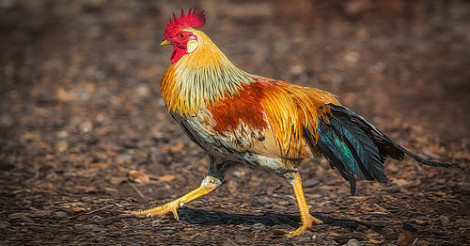

This week we are privileged to have a guest post from Kevin Birth, an anthropology professor at Queens College with expertise on the history of time. His other contributions to the ESN blog can be found here and a series on his book “Objects of Time” can be found here.
“Weeping may linger for the night, but joy comes with the morning” (Psalm 30:5, NRSV)
The poor rooster–long ago, Pope Gregory the Great dubbed it the wisest of all God’s creatures, and now it is a mere marketing icon for Kellogg’s corn flakes and deemed a nuisance by city folk who find themselves in the countryside with chickens.
Yet, the rooster plays an important role in the Gospel story of how Peter reacts to Jesus’ capture. Jesus had predicted that Peter would deny any association with Jesus before the second cockcrow. A modern reader of this is likely to think merely that Peter denied his association with Jesus before morning, but a meditation upon the crowing behavior of roosters suggests otherwise. When Peter understood the significance of his denial, it was still dark.
First, a bit of chronobiology. Roosters have pronounced circadian rhythms that are controlled by hormone cycles—particularly testosterone. Remove a rooster’s testes, and its crowing behavior goes away. But the circadian cycle is not independent of daylight, but instead functions to anticipate the rising of the Sun.
As is the case with many circadian cycles, the crowing cycle has a rough period of around 24-hours and is set by sunrise. So the sunrise that determines the rooster’s crow is that of the previous day, not the one about to come. As a result, the first cockcrow occurs a two to three hours before sunrise (as anyone who has tried to sleep through the night near roosters knows). The crowing then becomes more frequent as sunrise approaches.
So the story of Peter’s denial is not a story of rapid denials in succession, but a story of a drawn out period over which Peter denies Christ. If the rooster in the Gospel account was typical, the time between the first cockcrow and the second cockcrow would have been around 30 minutes. If the rooster started to crow about two hours before sunrise, then the second cockcrow would have occurred around what is known as “astronomical twilight”—a time when the sun is below the horizon but close enough for first light to be visible.
Maybe this is the reason why Jesus specified the second and not the first cockcrow. The first cockcrow occurs during nighttime darkness, but the second cockcrow is around the time of first light. Peter’s denial is in darkness, but his recognition of his shortcomings parallels this first glimmer of light anticipating the rising of the Sun.
Cockcrows and astronomical twilight are not durations, but temporal thresholds—significant, transformative moments. The story of Peter’s denial is not just one of time passing while he denies, but of the second cockcrow being a moment of revelation—a moment of insight in which Peter reflects on his denials and weeps, and a moment that changes Peter forever.
It is easy to think of Peter as the rock on which the Church is built, but this story emphasizes how feeble and weak Peter was that night. It was out of the prolonged period of weakness and being questioned that Peter emerges a broken, repentant, and stronger believer. He emerges from his shame not because of contemplation, or study, but the crowing of a humble rooster, a harbinger of dawn. The rooster did not signal that the Sun had risen, but that it would rise.
The Lenten season is a period in the northern hemisphere when darkness still outlasts daylight. The Paschal Feast (forgive me for not using the term Easter) occurs at a time when light is victorious—the first Sunday after the first full moon after the spring equinox. In the Bible’s frequent reference to metaphors of darkness and light, Lent is roughly parallel not only to the period of darkness in which Peter denies Jesus, but the moment of twilight in which he recognizes his denial and weeps over it. Because of cockcrow, Peter knew that the Sun was about to rise, even as we contemplate our own denials of Jesus during this period of darkness all the while in anticipation of the celebration of the Son’s rising.
Kevin Birth is a professor of anthropology at Queens College of the City University of New York. He is a specialist in the study of time. His books include Any Time is Trinidad Time: Social Meanings and Temporal Consciousness, and Objects of Time: How Things Shape Temporality. Among his many articles, he has also written on medieval European ideas of cockcrow: “The Regular Sound of the Cock” published in Kronoscope, volume 11 (2011).
Andy has worn many hats in his life. He knows this is a dreadfully clichéd notion, but since it is also literally true he uses it anyway. Among his current metaphorical hats: husband of one wife, father of two teenagers, reader of science fiction and science fact, enthusiast of contemporary symphonic music, and chief science officer. Previous metaphorical hats include: comp bio postdoc, molecular biology grad student, InterVarsity chapter president (that one came with a literal hat), music store clerk, house painter, and mosquito trapper. Among his more unique literal hats: British bobby, captain’s hats (of varying levels of authenticity) of several specific vessels, a deerstalker from 221B Baker St, and a railroad engineer’s cap. His monthly Science in Review is drawn from his weekly Science Corner posts — Wednesdays, 8am (Eastern) on the Emerging Scholars Network Blog. His book Faith across the Multiverse is available from Hendrickson.

Leave a Reply